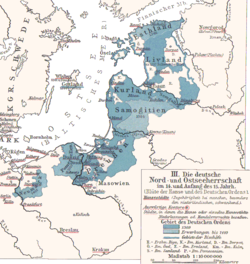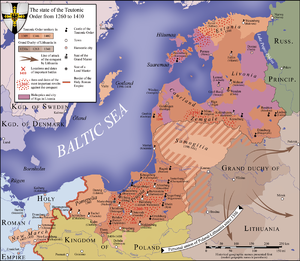State of the Teutonic Order
Order's State Ordensstaat | |||||||||||||
|---|---|---|---|---|---|---|---|---|---|---|---|---|---|
| 1224–1525 | |||||||||||||
 | |||||||||||||
| Status | Independent state | ||||||||||||
| Capital | Marienburg (1308–1454), Königsberg (1454–1525) | ||||||||||||
| Religion | Roman Catholicism | ||||||||||||
| Government | Theocracy | ||||||||||||
| Grand Master | |||||||||||||
• 1209–39 | Hermann von Salza | ||||||||||||
• 1510–25 | Albert of Brandenburg-Ansbach | ||||||||||||
| Historical era | Middle Ages | ||||||||||||
• Northern Crusades | 1224 | ||||||||||||
• Absorbed Livonia | 1237 | ||||||||||||
• Purchased Neumark | 1404 | ||||||||||||
• Hanseatic cities¹ leave, found Prussian Confed. | 1440 | ||||||||||||
• War of the Priests | 1467–79 | ||||||||||||
| 1525 | |||||||||||||
| |||||||||||||
1. The Hanseatic cities that seceded from the Teutonic Knights in 1440 were Danzig (Gdańsk), Elbing (Elbląg) and Thorn (Toruń) | |||||||||||||
The State of the Teutonic Order, (German: Deutschordensland), also Monastic State of the Teutonic Knights or Ordensstaat[1] (pronounced [ˈɔɐdənsˌʃtaːt] "Order-State"), was formed in 1224 during the Northern Crusades, the Teutonic Knights' conquest of the pagan West-Baltic Old Prussians (Template:Lang-la) in the 13th century.
The Livonian Brothers of the Sword controlling Livonia were incorporated into the Teutonic Order as its autonomous branch Livonian Order in 1237.[2]
In 1346, the Duchy of Estonia was sold by the King of Denmark for 19,000 Köln marks to the Teutonic Order. The shift of sovereignty from Denmark to the Teutonic Order took place on November 1, 1346 [3] Following its defeat in the Battle of Grunwald in 1410 the Teutonic Order fell into decline and its Livonian branch joined the Livonian Confederation established in 1422–1435.[4]
The Teutonic lands in Prussia were split in two after the Peace of Thorn in 1466. The western part of Teutonic Prussia was converted into Royal Prussia which became a more integral part of Poland. The monastic state in the east was secularized in 1525 during the Protestant Reformation when it was replaced by the Duchy of Prussia, a Polish fief governed by the House of Hohenzollern.
In old texts and in Latin the term Prut(h)enia refers to "Teutonic Prussia", "Royal Prussia" and '"Ducal Prussia" alike. The pertaining contemporary adjective is Prut(h)enic.
Background
| History of Brandenburg and Prussia |
|---|
  |
|
| Present |
|
Prussia withstood many attempts at conquest preceding the Teutonic Knights'. Bolesław I the Brave of Poland began the series of unsuccessful conquests when he sent Adalbert of Prague in 997. In 1147, Boleslaw IV of Poland attacked Prussia with the aid of Kievan Rus, but was unable to conquer it. Numerous other attempts followed, and, under Duke Konrad I of Masovia, were intensified, with large battles and crusades in 1209, 1219, 1220, and 1222.[5]
The West-Baltic Prussians successfully repelled most of the campaigns and managed to strike Konrad in retaliation. However the Prussians and Yotvingians in the south had their territory conquered. The Yotvingians land was situated in the area of what is today Podlesia. The Prussians attempted to oust Polish or Masovian forces from Sudovia and Kulmerland or Chełmno Land, which by now was partially conquered, devastated and almost totally depopulated. Konrad of Masovia had already called a crusade against Prussians in 1208, but it was not successful. Konrad, acting on the advice of Christian, first bishop of Prussia, established the Dobriner Orden, a small group of 15 knights. The Order, however, was soon defeated and, in reaction, Konrad called on the Pope for yet another crusade and for help from the Teutonic Knights.
As a result, several edicts called for crusades against the Prussians. The crusades, involving many of Europe's knights, lasted for sixty years.
In 1211, Andrew II of Hungary granted the Burzenland fiefdom to the Teutonic Knights. In 1225, Andrew II expelled the Teutonic Knights from Transylvania, and they had to transfer to the Baltic Sea.
Early in 1224, Emperor Frederick II announced at Catania that Livonia, Prussia with Sambia, and a number of neighboring provinces were under Imperial immediacy (German: Reichsfreiheit). This decree subordinated the provinces directly to the Roman Catholic Church and the Holy Roman Emperor as opposed to being under the jurisdiction of local rulers.
At the end of 1224, Pope Honorius III announced to all Christendom his appointment of Bishop William of Modena as the Papal Legate for Livonia, Prussia, and other countries.
As a result of the Imperial Bull of Rimini and the Papal Bull of Rieti, Prussia came into the Teutonic Order's possession. Under their governance, woodlands were cleared and marshlands made arable, upon which many cities and villages were founded, including Marienburg (today Malbork) and Königsberg (today Kaliningrad).
Further history


13th century
In 1234, the Teutonic Order assimilated the remaining members of the Order of Dobrzyń and, in 1237, the Livonian Brothers of the Sword. The assimilation of the Livonian Brothers of the Sword (established in Livonia in 1202) increased the Teutonic Order's lands with the addition of the territories known today as Latvia and Estonia.
In 1243, the Papal legate William of Modena divided Prussia into four bishoprics: Culmerland, Pomesania, Warmia, and Sambia. The bishoprics were ruled by the Archbishopric of Riga under the mother city of Visby on Gotland.
14th century
At the beginning of the 14th century, the Duchy of Pomerania, a neighboring region, plunged into war with Poland and the Margraviate of Brandenburg to the west. The Margraves of Brandenburg, who ruled Pomerelia in the 1250s, entered into a treaty on August 8, 1305 with Wenceslaus III of Bohemia, then King of Poland.
In the Teutonic takeover of Danzig, the Teutonic Knights seized the city in November 1308. The Order had been called by King Władysław I of Poland. According to historical sources, many of the inhabitants of the city, Polish and German, were slaughtered. In September 1309, Margrave Waldemar of Brandenburg sold his claim to the territory to the Teutonic Order for the sum of 10,000 Marks in the Treaty of Soldin. This marked the beginning of a series of conflicts between Poland and the Teutonic Knights as the Order continued incorporating territories into its domains.
The Teutonic Order's possession of Danzig was disputed by the Polish kings Władysław I and Casimir the Great -- claims that led to a series of bloody wars and, eventually, legal battles in the papal court in 1320 and 1333. Finally, in 1343, peace was concluded at Kalisz, where the Teutonic Order agreed that Poland should rule Pomerelia as a fief and Polish kings, therefore, retained the right to the title Duke of Pomerania.
15th century

In 1402, the Teutonic Order acquired the Brandenburgian Neumark, and kept it until it was pawned or sold back in 1454 and 1455, respectively, by the Treaties of Cölln and Mewe.
In 1410, with the death of Rupert, King of the Germans, war broke out between the Teutonic Knights and a Polish-Lithuanian alliance supported by Ruthenian and Tatar auxiliary forces. Poland and Lithuania triumphed following a victory at the Battle of Grunwald (Tannenberg). The Order assigned Heinrich von Plauen to defend Pomerania, who moved rapidly to bolster the defence of Castle Marienburg in Prussia. Heinrich von Plauen was elected vice-grand master and led the Teutonic Knights through the Siege of Marienburg in 1410. Eventually von Plauen was promoted to Grand Master and, in 1411, concluded the First Treaty of Thorn with King Władysław II Jagiełło of Poland.
In March 1440, gentry (mainly from Culmerland) and the Hanseatic cities of Danzig, Elbing, Thorn and other Prussian cities founded the Prussian Confederation to free themselves from the overlordship of the Teutonic Knights. Due to the heavy losses and costs after the war against Poland and Lithuania, the Teutonic Order collected taxes at steep rates. Furthermore, the cities were not allowed due representation by the Teutonic Order. In February of 1454, the Prussian Confederation asked King Casimir IV of Poland to support their revolt and incorporate Prussia into Poland. King Casimir IV agreed and the War of the Cities or Thirteen Years' War broke out. The Second Peace of Thorn in October of 1466 ended the war and provided for the Teutonic Order's cession of its rights over the western half of its territories to the Polish crown, which became the province of Royal Prussia and the remaining part of the Order's land became a fief of Poland.
16th century
During the Protestant Reformation, endemic religious upheavals and wars occurred across the region. In 1525, during the aftermath of the Polish-Teutonic War (1519–1521), Sigismund II Augustus, King of Poland, and his nephew, the last Grand Master of the Teutonic Knights, Albert of Brandenburg-Ansbach, a member of a cadet branch of the House of Hohenzollern, agreed that the latter would resign his position, adopt the Lutheran faith and assume the title of Duke of Prussia. Thereafter referred to as Ducal Prussia (German: Herzogliches Preußen) (Template:Lang-pl), it remained a Polish fief. Thus in a deal partially brokered by Martin Luther, the Roman Catholic Teutonic State was transformed into the Duchy of Prussia (German: Herzogtum Preußen), the first Protestant state. Sigismund's consent was bound to Albert's submission to Poland, which became known as the 'Prussian Homage'.
The Habsburg-led Holy Roman Empire continued to hold its claim to Prussia and furnished grand masters, who were merely titular administrators of Prussia. In 1618, the Duchy of Prussia passed to the senior Hohenzollern branch, the ruling margraves and prince-electors of Brandenburg, who ruled Brandenburg (a fief of the Holy Roman Empire), and Ducal Prussia (a Polish fief), in personal union. This legal contradiction made a cross-border real union impossible; however, in practice, Brandenburg and Ducal Prussia were more and more ruled as one, and colloquially referred to as Brandenburg-Prussia which functioned as a personal union.
Frederick William, Duke of Prussia and Prince-elector of Brandenburg, sought to acquire Royal Prussia in order to territorially connect his two existing fiefs. An opportunity occurred when Charles X Gustav of Sweden, in his attempt to conquer Poland (cf. Swedish Deluge), promised to cede to Frederick William the Prince-Bishopric of Ermland and four further Polish voivodeships, if Frederick William supported the Swedish campaign. This offer was speculative, since Frederick William would have to commit to military support of the campaign, while the reward was conditional on achieving victory.
John II Casimir of Poland forestalled the Swedish-Prussian alliance by submitting a counter-offer, which Frederick William accepted. On July 29, 1657 they signed the Treaty of Wehlau in Wehlau (Template:Lang-pl. In return for Frederick William's renunciation of the Swedish-Prussian alliance, John Casimir recognised Frederick William's full sovereignty over the Duchy of Prussia. In 1701, after almost 200 years of Polish suzerainty, Prussia regained full sovereignty, a necessary prerequisite for elevating Ducal Prussia to become the sovereign Kingdom of Prussia (not to be confused with Polish Royal Prussia). The nature of the de facto collectively ruled governance of Brandenburg-Prussia became more apparent through the titles of the higher ranks of the Prussian government, seated in Brandenburg's capital of Berlin. However, the legal amalgamation of the Kingdom of Prussia (a sovereign state) with Brandenburg (a fief of the Holy Roman Empire) was only achieved after the dissolution of the Empire in 1806.
See also
References
- ^ France, John (2005). The Crusades and the Expansion of Catholic Christendom, 1000-1714. New York: Routledge. p. 380. ISBN 0415371287.
- ^ Frucht, Richard C. (2005). Eastern Europe: An Introduction to the People, Lands, and Culture. ABC-CLIO. p. 69. ISBN 1576078000.
{{cite book}}: Cite has empty unknown parameter:|coauthors=(help) - ^ Skyum-Nielsen, Niels (1981). Danish Medieval History & Saxo Grammaticus. Museum Tusculanum Press. p. 129. ISBN 8788073300.
{{cite book}}: Cite has empty unknown parameter:|coauthors=(help) - ^ Housley, Norman (1992). The later Crusades, 1274-1580. p. 371. ISBN 0198221363.
{{cite book}}: Cite has empty unknown parameter:|coauthors=(help) - ^ Edward Henry Lewinski Corwin The Political History of Poland. 1917, The Polish Book Importing Company p45.
External links
- Ordensland.de: cities, castles and landscapes of the Teutonic Knights Template:De icon



